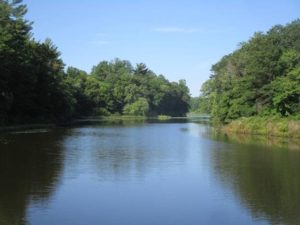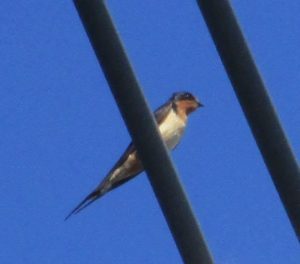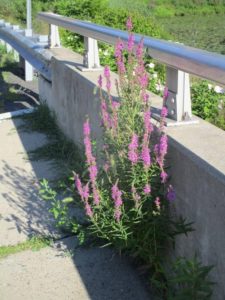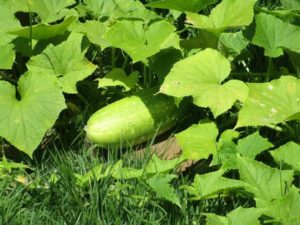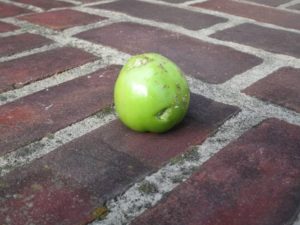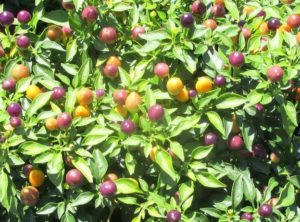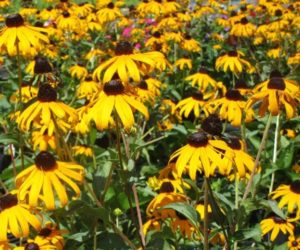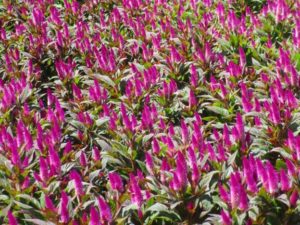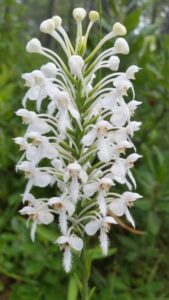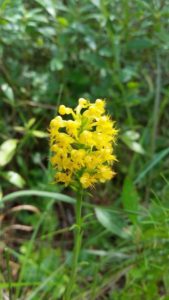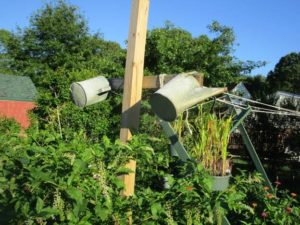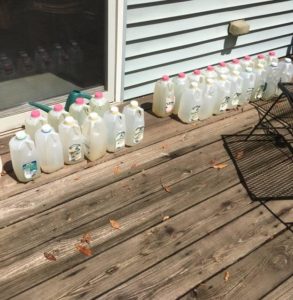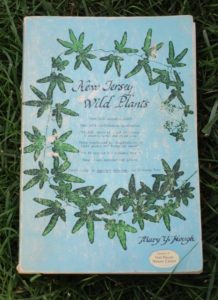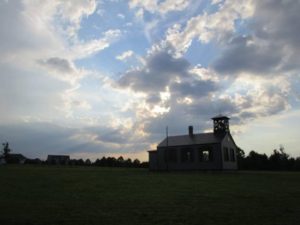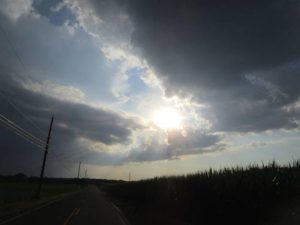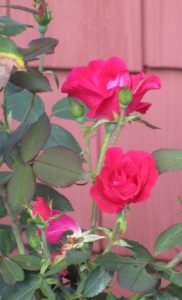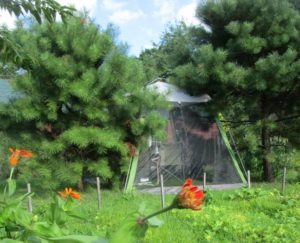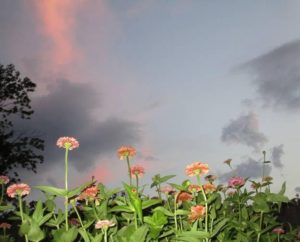Notes from Garden & Afield: July 30-August 5, 2017
Article and photos by Joe Sapia, except as noted
Note: The yard references are to my house in the section of Monroe between Helmetta and Jamesburg in South Middlesex County. My yard is in a Pine Barrens outlier on the Inner Coastal Plain, the soil is loamy, and my neighborhood is on the boundary of Gardening Zones 6b (cooler) and 7a (warmer). Notes and photographs are for the period covered, unless otherwise noted.
This scene, on August 2, Wednesday, at the Sears department store in New Brunswick, Middlesex County, kind of sums up this summer’s weather: alternating pouring rain and blue sky.
FARRINGTON LAKE: I love kayaking Farrington Lake on the boundary of South Brunswick, North Brunswick, and East Brunswick, all in Middlesex County. It is slender, about 3-1/2 miles long. Because there is so much forest lining the shores, it has a feel of being in the Adirondacks or some other place that is remote, rather than on the edge of suburbia as it is. This week, I did not kayak, but simply stopped to grab some quick photographs. Of course, the lake, created by the damming of Lawrence Brook basically between Davidson Mill Pond Park and Milltown, is beautiful, but I also saw a beautiful flower, purple loosestrife, “Lythrum salicaria.” The problem is purple loosestrife is non-native, highly invasive species, clogging the wetlands ecosystem. On the bright side, I was entertained by swallows. They fluttered around the lake, searching for bugs to eat.
Farrington Lake, looking south toward Route 130 from the Church Lane bridge.
A barn swallow, “Hirundo rustica,” perches on a utility line above Farrington Lake.
Purple loosestrife, even coming up through a crack in the sidewalk on the Church Lane bridge crossing Farrington Lake.
IN THE GARDEN: Cucumbers, cantaloupe, sweet corn, and tomatillos continue to grow, not yet ready to harvest. Remember me mentioning how I did not plant the tomatillos? Well, now, the garden is sprouting what appears to be gourds, which I did not plant. The zinnias continue to bloom wonderfully. And looking to the fall, I planted carrots. I went to Tony’s Farm and Garden Center in Robbinsville, Mercer County, and picked up more seeds for a fall crop: Detroit Red Medium Top Beets, Touchon Heirloom Carrots, Sugar Snappy Peas, Sugar Daddy Heirloom Peas, and Snowbird Peas, all Burpee brand.
Here come the cucumbers. I place a brick underneath the cukes and mushmelons to keep them from having contact with the ground, leading to rot.
Which one of my yard friends bit into this green tomato?
GARDEN TALK: While at Tony’s Farm and Garden Center, I got talking to Tony Ciacco, the third generation of the Ciacco family to own and run the center. Tony mentioned the lack of bees in the environment, as we stood in amidst rows of flowers. Among those flowers, few, if any bees, which act as pollinators, flew around. In the past, the center would warn customers of bees flying around its greenhouses, Tony said. Later that afternoon, neighbor Tom DeRose and I stood in my zinnia patch. The zinnia patch noticeably has butterflies moving from flower to flower, but hardly any bees. We are in real trouble if we measure pollination by bees. Tom also mentioned his garden is having a bad year for carrots with a lot of green but little fruit. My carrots, too, are not doing great – some with clusters of nice carrots, some with lots of green but not good carrot production.
COLOR AT TONY’S: When I go to Tony’s Farm and Garden Center, I try to shoot photos because there is a lot of color in the plantlife.
BALD EAGLES: I got a report of bald eagles, “Haliaeetus leucocephalus,” having a nest this season along the Raritan River just north of downtown New Brunswick. Also, the state Department of Environmental Protection confirmed a nest, which fledged one chick, in my hometown of Monroe. So, I have been keeping an eye out for eagles flying around near that nest, which is in the area of Route 33 and Applegarth Road/Butcher Road.
ORCHIDS IN THE PINE BARRENS: Faye Bray, a friend and outdoorswoman who lives in the main Pine Barrens, comes through again with beautiful reports of orchids. This time, the white-fringed, “Habernaria blephariglottis,” and the yellow-fringed, “Habernaria ciliaris.” Both were found recently in the Oswego Lake, Burlington County, area of the main Pine Barrens.
White-fringed orchid in the Oswego Lake area, Burlington County, of the Pine Barrens. (Photo copyright 2017 by Faye Bray.)
Yellow-fringed orchid in the Oswego Lake area of the Pine Barrens. (Photo copyright 2017 by Faye Bray.)
LOW MOISTURE IN THE AIR: When I am out in the garden, or the yard in general, I try to observe the world around me – basically the woods around me, The Swamp down the street, and the sky. As for the sky, on July 30, Sunday, Joey Slezak, a meteorologist and my go-to science guy in Helmetta, texted me, “Bluebird skies this morning! Low humidity!” Yes, the sky had that clear look to it because moisture was not clogging up the air. A great day to do yard work. I texted back, “Going out to cut lawn, camera in hand.” On days such as this, it feels as though one could reach up and touch airplanes passing by.
A JetBlue Airbus cruises by at about 240 knots at approximately 4,800 feet on its way from Fort Lauderdale, Florida, to Newark, Essex County. (How do I know the details on this aircraft? From following my new obsession, www.flightradar24.com.)
OBSESSION, NO. 2, WATERING THE GARDEN: In recent days, I have gone from daily watering (except when for days when it is raining) to more sporadic watering. If nothing else, I was worried the cantaloupe and sweet corn were getting too much water, especially because of the recent rain.
GRANDMA’S WATERING CANS: Normally, I water the garden using house water with hose and sprinkler. When I accumulate enough water in my water barrels, which can hold 20 gallons and 30 gallons, I use sprinkling cans I had around the house. At least one of them is Grandma Annie Onda’s. The other one, if not Grandma’s, was Ma and Pops’s. Those watering cans must date to the 1960s or earlier. One of them has a pretty severe leak. But they are still being put to good use. (Grandma, Ma, and Pops are deceased — Grandma in 1972, Ma in 1995, and Pops in 2006 — but their implements around the house are still being used by me.
The old watering cans.
MORE WATERING WAYS: Jack Mahon – a South Jersey gardener, naturalist, and birder – shared his watering ways: “First, basement de-humidifier drains to bucket in sink. Milk jugs are filled from bucket. If we’re away, I just let it (the dehumidifier) drain directly into the sink. Next, jugs on back deck. Some have white caps, some pink. The pink ones would have a very diluted liquid plant food that I use in the first half of the season. Right now, though, they are 100 percent water. At end of August, I’ll start another very weak fertilizer routine, phosphorus & potash rather than the spring nitrogen-based. Finally, four of the crop, American beech, crepe myrtle, black pine, and willow oak. I only bother with hardy varieties that can overwinter in a cold frame.”
Jack Mahon’s recycled de-humidifier water to be used for potted trees he is raising. White caps mean pure water. Pink caps mean water diluted with plant food. (Photos supplied by Jack Mahon.)
BOOKS FOR THE JERSEY MIDLANDS NATURALIST, NO. 2: Years ago, I picked up a valuable book at New Jersey Audubon’s Owl Haven nature center at Monmouth Battlefield State Park in Monmouth County – “New Jersey Wild Plants” by Mary Y. Hough, a plant ecologist and taxonomist, 1983, Harmony Press, Harmony, N.J. The book lists plantlife alphabetically by its scientific name. So, most of us probably would need to use another source using common names, then check Mary’s book. As Rutgers University botanist David E. Fairbrothers wrote in the book’s preface, “This publication was designed as a New Jersey supplement for current field guides and technical manuals. …Included are all native and introduced species of club mosses, conifers, ferns, flowering plants, horsetails, quillworts, and spikemosses growing without cultivation in the state. …It is indeed a welcome addition for professional and non-professional biologists and/or naturalists, because it provides information about species for the entire state, much of which is not available or scattered in many sources, because of a lack of a “Manual of the Flora of New Jersey.” Mary Hough deserves our appreciation for having produced a useful information source about the interesting flora of a very floristic geographical area….” What I love about this book is it tells New Jersey bloom times, lists habitat and general state locations for finding the species, and gives a tidbit of more information such as the plant being poisonous or a little of the history in finding the plantlife. Owl Haven is long gone, but Hough’s book still proves invaluable. It is one of the most-used books in my outdoors collection. (Note: One, books mentioned in this series may be out of print. Two, Dr. Fairbrothers, now deceased, was a very informative and kind mentor of my pursuits in the Spotswood Outlier of the Pine Barrens.)
Mary Y. Hough’s “New Jersey Wild Plants”
Y. Hough’s “New Jersey Wild Plants.” Here, the listings for sheep laurel, “Kalmia angustifolia,” and mountain laurel, “Kalmia latifolia.”
MUSHROOMS: I have seen some chatter regarding the edibility of mushrooms on a Pine Barrens Facebook page I follow. I am 60-years-old and lifelong Jersey Midlands and I feel comfortable picking only two types of mushrooms. I will not identify them for this conversation because I do not want to confuse anyone on what is edible. So my basic advice, only feel safe eating a locally found mushroom if a COMPETENT picker OKs it. Remember the adage: “There are old mushroom pickers. There are bold mushroom pickers. There are no old AND bold mushroom pickers.”
CLOUDS: Over the last several months, we have been blessed with beautiful views of cloudy skies…
At the Dey Farm Historic Site in Monroe.
Farmland at the Applegarth section of Monroe.
At the Johnson and Johnson clock tower in New Brunswick.
IN THE YARD, ROSES: There seems to be a sporadic, but beautiful, bloom on the “Knock Out” roses in my backyard. So, I will call this a continuation of the second bloom of the season, rather than a third bloom. The rose bushes did get somewhat battered during the recent outside remodeling of my house that lasted from mid-June to late July. Perhaps that is the reason for sporadic blooming.
The “Knock Out” roses in bloom in the backyard.
OCEAN TEMPERATURES: Atlantic Ocean temperatures on the New Jersey coast were in the range of 73 to 76 degrees on Saturday, August 5.
UPCOMING COUNTY FAIRS: Middlesex County Fair, August 7, Monday, to August 13, Sunday, in East Brunswick, http://middlesexcountyfair.com/. Somerset County 4-H Fair, August 9, Wednesday, to August 11, Friday, in Bridgewater, http://www.somersetcounty4h.org/fair/. Hunterdon County 4-H and Agricultural Fair, August 23, Wednesday, to August 27, Sunday.
OTHER UPCOMING: There will be a solar eclipse August 21, Monday.
SUNRISE/SUNSET: For Aug. 6, Sunday, to August 12, Saturday, the sun will rise at about 6 to 6:05 a.m. and set about 8 to 8:05 p.m.
WEATHER: The National Weather Service forecasting station for the area is at http://www.weather.gov/phi/.
JOEY’S WORLD: On Saturday, August 5, I found one of my garden buckets filled with water and thought, When did it rain hard? But neighbor Tom DeRose informed me the neighborhood had a severe thunderstorm after midnight and before dawn. We did? Oh, boy, I must have pretty much slept through it.
SCREEN TENT: A few weeks back, I ordered a Coleman screen tent. I wanted a simple way to enjoy the backyard without mosquitoes biting me. I had to wait for the remodeling contractors to be gone, before I could regain control of my yard, including putting up the tent. What a buy for about $60 or so dollars. I did write much of this blog in the tent. Now, to find more time to enjoy the tent.
The screen tent nestled between two pitch pines, “Pinus rigida,” the food-flower garden, and lawn.
A PLAN FOR NEXT YEAR: Simply, as little lawn as possible. Translated, more space for growing food and zinnias, less grass for me to cut.
Beautiful zinnias in the garden and a beautiful sky in the background.
Joe Sapia, 60, is a lifelong Monroe resident. He is a Pine Barrens naturalist and an organic vegetable-fruit gardener. He gardens the same backyard plot as did his Italian-American father, Joe Sr., and his Polish-immigrant, maternal grandmother, Annie Poznanski Onda. Both are inspirations for his food gardening. Joe is active with the Rutgers University Master Gardeners/Middlesex County program. He draws inspiration on the Pine Barrens around Helmetta from his mother, Sophie Onda Sapia, who lived her whole life in these Pines, and his Grandma Annie. Joe’s work also is at @JosephSapia on Twitter.com, along with Facebook.com on the Jersey Midlands page. Copyright 2017 by Joseph Sapia


